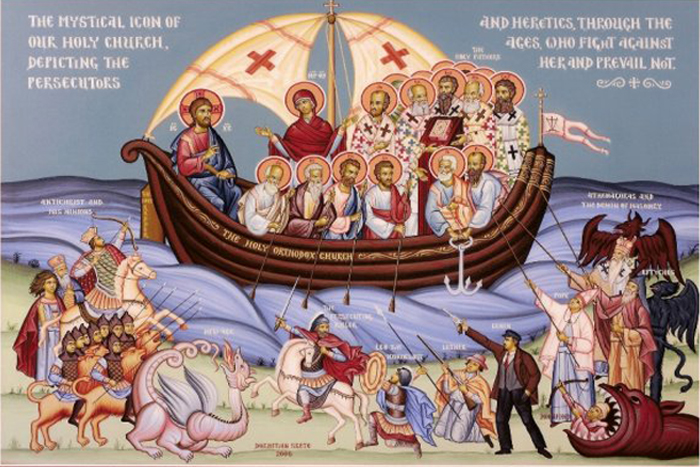
The Church commemorated the Holy Fathers of the Fourth Ecumenical Council on June 29. This Council was the greatest event in the history of the Church and one of the pillars of Orthodoxy, the lasting importance of which cannot be overstated. The Fathers of the Council worked out a model dogmatic definition of the balance of natures in the Hypostasis of the Lord Jesus Christ, which is still the basis of Orthodox Christianity. Let us recall the main facts about this Council in this article.
1. The Council of Chalcedon was the Fourth Ecumenical Council of the Church of Christ, convened under Emperor Marcian in 451 in the town of Chalcedon, near Constantinople, to condemn the heresy of Archimandrite Eutyches known as Monophysitism. Its sessions lasted about a month and were held in the Church of the Great Martyr Euthymia. A total of about sixteen sessions of the Council were held.
2. The Council of Chalcedon was one of the most representative, as well as the most well-documented of the seven Ecumenical Councils, which was attended by more than 520 people, including authorized presbyters. The meetings of the Council were presided over by imperial officials, who, however, had no say in its decisions.
3. Bishop Dioscorus of Alexandria, who had presided over the Robber Council in Ephesus in 449, was convicted and deposed for his rude conduct and disrespect of the Council (the accused did not attend several sessions, despite having been summoned by the Fathers three times). Other participants of the Council were forgiven because they had repented, agreed with Dioscorus’ deposition and signed the Chalcedonian Oros. Besides, the Blessed Theodoret of Cyrus, who had earlier sharply criticized St. Cyril, was acquitted after anathematizing Nestorius.
4. The Fathers of the Council denounced both Monophysitism and Nestorianism, taking the best from and avoiding the extremes of the Alexandrian and Antiochian theological schools, following the golden Orthodox path. The dogma of the Council of Chalcedon was based on the letter of the Holy Pope Leo (†461) to St. Flavian of Constantinople (†449), which asserted the union of Divine and human natures in one Hypostasis, one Person of the Lord Jesus Christ, who is one with the Father in Godhead, and with us in humanity, who is like us in everything but sin.
5. The agreement of the Fathers of the Council with the letter of Pope Leo to St. Flavian was not automatic and unequivocal. Some of the Fathers doubted the orthodoxy of the Bishop of Rome, considering some passages of his letter as potentially Nestorian. A special commission headed by Anatoly, Bishop of Constantinople, was established within the Council to look into this issue for five days. Comparing the Christology of the Pope Leo with the undisputed authority of the twelve anathematisms of St. Cyril of Alexandria, approved by the Third Ecumenical Council, the Fathers were convinced of the orthodoxy of the Primate of the Roman Church.
6. The Fathers issued thirty canons, among which the most significant and controversial was the 28th Rule, which promoted the See of Constantinople to the second position in the Diptychs after the See of Rome, justifying it by the fact that the city of Constantine was the seat of an empire, and of a senate, which meant that now it was New Rome and had to be elevated like the Old Rome. St. Leo criticized this rule, arguing that it violated the traditional hierarchy of churches, approved by the canons of Nicaea, according to which the second place in the hierarchy had been assigned to the Church of Alexandria.
7. The Fathers of the Council, for the sake of the holiness of the place, decided to honor the Church of the Holy City of Jerusalem, which until then had been part of the Diocese of the East and therefore was subordinate to the Archbishop of Antioch. During the seventh session, the Fathers decided to exclude this Church of Jerusalem, which received autocephaly, from the jurisdiction of Antioch. By doing so, they laid the groundwork for the pentarchy, a system of five patriarchates that had developed around the ancient Churches of Rome, Constantinople, Alexandria, Antioch, and Jerusalem.
8. Becoming the basis of Orthodox theology, the Council of Chalcedon did not manage to heal the division between the Churches and did not put an end to Christological disputes. The majority of Christians in Alexandria, Antioch, and Armenia did not accept the dogma of Chalcedon, considering it to be Nestorian, while the Churches of Rome, Constantinople, Jerusalem, and later also of Georgia remained faithful to the rulings of the Fathers who had assembled in Chalcedon.
The significance of the Council of Chalcedon is still very relevant. Some Christians who go to church, pray to God and are not particularly interested in theology, considering it unnecessary and even harmful to salvation, tend to think of Christ only as God, forgetting that Jesus is a human being like us but only without sin, which makes such believers latent monophysites. There is another extreme when many see Jesus as merely a human being, forgetting or even denying his divine dignity. Both positions do not align with the truths set forth in the Gospel of Jesus Christ. Knowledge of the core principles of Orthodox dogma helps to avoid false ideas about God, which can have a negative impact on both the worldview of man and his spiritual experience.



